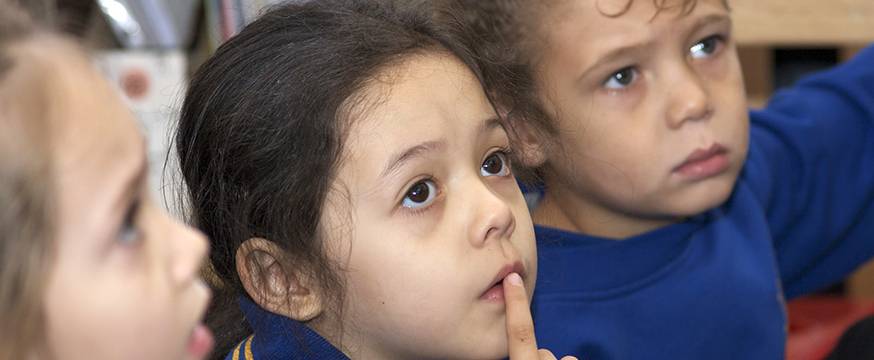
A positive start: Using television to support Indigenous learning
Research 19 Jan 2017 5 minute readResearch shows that educational television programs can support a successful transition from home to school for young Indigenous children and their families, and improve long-term outcomes for Indigenous students.
A positive start: Using television to support Indigenous learning
The development of Little J & Big Cuz, a ground-breaking initiative that aims to improve educational outcomes for Indigenous children by focusing on the transition from home to school (as reported in Research Developments in October), is underpinned by extensive research.
Indigenous children beginning school can face challenges that put them at a disadvantage, particularly if they do not speak English as a first language or live in low socioeconomic communities and remote locations.
These observations are supported by the 2015 National Assessment Program – Literacy and Numeracy (NAPLAN) data, which, despite showing encouraging progress in beginning to close the education gap between Indigenous and non-Indigenous students, tells a familiar story of prevailing inequity and sizeable gaps.
The importance of the early years
According to former ACER Principal Research Fellow, Tony Dreise, Indigenous children start solidly in the early years of schooling, but gaps generally widen the further they climb the education ladder, a problem that causes but also results from lower levels of school attendance and participation.
In the Charles Sturt University Transition to School Position Statement, Professors Sue Docket and Jóhanna Einarsdótti, and Emeritus Professor Aline-Wendy Dunlop note that a successful start to school is linked to later positive educational and social outcomes, and that children who have a positive start to school are likely to regard school as an important place and to have positive expectations of their ability to learn and succeed at school.
A 2012 ACER research report confirmed the importance of resilience in supporting a successful transition to school, with family support, strong cultural identity, good health, positive self-identity and engagement in shared activities such as storytelling likely to lead to resilience in Aboriginal and Torres Strait Islander children.
In terms of how to support a successful start to school, ACER’s 2010 report Using television to improve learning opportunities for Indigenous children, by Dr Michele Lonsdale, noted that extensive research shows the critical importance of early childhood in children’s learning and development, and subsequent educational and life outcomes.
Given that participation rates in early childhood programs are lower for Indigenous children than for their non-Indigenous peers and that television viewing is a popular activity for preschool-aged children, Dr Lonsdale concluded that quality educational television programs that promote engagement with learning at an early age, support home-to school transition, and recognise the importance of cultural awareness are needed to maximise learning opportunities for Indigenous young people.
Educational television programs
According to Dr Lonsdale, international studies show that educational television programs can help improve children’s transition to school by building literacy and numeracy skills, cultural awareness, self-esteem and appropriate behaviours, with such educational benefits potentially lasting into secondary school.
Dr Lonsdale noted that the Spanish version of Sesame Street has been found to have a positive impact on cognitive and perceptual abilities, while the South African and Egyptian versions have raised awareness of important social issues, and an equivalent program in Turkey was found to have enhanced the transition to school among preschool children from low socioeconomic status backgrounds.
As for the original Sesame Street, Dr Lonsdale noted that it has been the focus of more than 1000 studies since it first went to air in 1969, and has proven that a well-designed and age-targeted educational television series can be both entertaining and beneficial for children.
TV series for Indigenous children
In terms of Indigenous children, Dr Lonsdale says studies in countries such as Canada and New Zealand suggest that television is playing a critical role in revitalising Indigenous languages and encouraging a sense of pride among Indigenous viewers.
Such television series not only help Indigenous children to learn about, and strengthen their sense of connectedness to, their culture, but also improve the cultural understanding of non-Indigenous children.
Dr Lonsdale’s research was instrumental in supporting ACER’s efforts to develop a high-quality educational television series aimed primarily at Aboriginal and Torres Strait Islander children aged three to six years. Following extensive development, the animated series, Little J & Big Cuz, is set to premier on NITV Easter 2017 and will be made available in Indigenous languages.
One of the strengths of Little J & Big Cuz is that it seeks to build on the cultural knowledge, values and aspirations of Indigenous communities and connects these within the formal school environment
This feature also makes it suitable for developing non-Indigenous children’s knowledge, understanding and skills relating to Aboriginal and Torres Strait Islander ways of knowing and being.
Find out more:
For further information about Little J & Big Cuz, read ‘Little J and Big Cuz ready for school’ in ACER’s Research Developments.
Read the full report:
Using television to improve learning opportunities for Indigenous Children, by Michele Lonsdale, Australian Council for Educational Research (2010).
